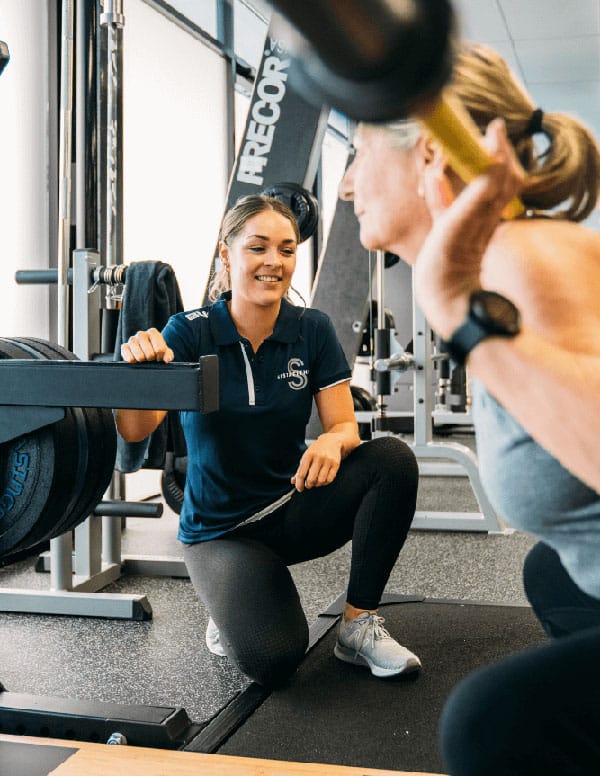Functional training has been around for many decades, but it’s really gained popularity in the fitness community in recent years. Also called HIIT (High-Intensity Interval Training), “functional training” is a term that describes exercises designed to not only keep you fit and active, but help you perform activities in everyday life more easily, safely, and confidently.
Unlike bodybuilding-style training, which focuses on select muscle groups at a given time, functional exercises typically use the whole body. By utilising multiple muscle groups at the same time, there’s an emphasis on core strength and stability.
Examples of functional training movements
Since functional training is based around improving everyday movements, exercises under this umbrella generally include squatting, balance-based movements, lifting, jumping, and much more.
Fun fact!
Functional training can be enjoyed by anyone, but there is much cross-over with physiotherapy movements. For example, an older person might practice light bodyweight squats to improve their ability to stand up from a chair independently — an essential everyday movement. This is a great real-life example of type functional training!
Benefits of functional training
The way we see it, there are six main benefits women gain from a regular functional training regime.
1. Improved movement patterns.
Your body was made to move, and functional training will help you improve muscle movement patterns. By “patterns” we mean hinging, squatting, lunging, pushing, pulling, and rotating. These patterns are used every day. Building them up will help you improve muscle strength, balance and efficiency when completing these patterns.
Functional training programs also help reduce the risk of injury by improving overall coordination and mobility. For example, let’s say you’re using an Olympic bar for a bent-over row with a palm-up grip. This movement focuses on the pulling pattern, which improves range-of-motion of the shoulder joint (when done with the correct technique) while also enhancing coordination between your core and secondary muscles (e.g. muscles in the legs) responsible for keeping the body stable.
2. Healthy physique & lean muscle mass.
Because functional training uses multiple muscle groups at the same time, regularly engaging in these exercises (along with a balanced diet) can help you reach and maintain a healthy weight. A functional training program can assist in developing a leaner, athletic-looking body (as opposed to a broad and stocky bodybuilder’s body). Think about it: the reason many athletes and dancers have lean muscle mass is because they’re performing movements that use the entire body — which is the premise of functional training.
3. Natural anti-aging (kind of).
Functional training programs can help aging gym–goers maintain strength and lean muscle mass, even well into their later years. This is because muscle fibres work on a “use-it-or-lose-it” system. When muscle fibres responsible for strength and definition are not used regularly, they can atrophy which results in losses of strength and definition. High-intensity exercises, like those found throughout functional training, keep these fibres engaged so older women stay fitter, mobile, and stronger for longer. Okay, it’s not really anti-aging, but it can slow the aging process down and help women enjoy independence well into their twilight years.
4. Increased calorie burn
Quite simply, functional training can help you burn more calories when compared to traditional strength training. On average, your body burns five calories of energy to consume one litre of oxygen. Ipso facto, the more muscles you use at one time, the more oxygen you’ll consume, and the more calories you’ll burn.
This is particularly handy if one of your primary fitness goals is to lose weight. Burning more calories than you eat in a day is referred to as a “calorie deficit”, which is the basis of many weight-loss programs. So, a healthy diet combined with functional training (and a whole lot of hard work and dedication!) is a pretty surefire way to shed those extra kilos.
5. More results in less time.
In a recent study, research compared results from a four-minute Tabata cycle to those running on a treadmill for 30 minutes. Side note: Tabata is one of the structures used for functional training — it’s the one we use at Sista Fitness!
Participants completing Tabata were doing HIIT for 12 minutes a week, while the treadmill runners were running at a moderate level of intensity for 90 minutes a week. At the end of the study, the Tabata group had improved their aerobic capacity and time-to-exhaustion more than the 30-minute treadmill group. To put it simply, 12 minutes of HIIT Tabata a week yielded better results than 90 minutes each week on a treadmill.
5. Improved aerobic capacity.
If you love activities like dancing, swimming or running, functional training can support and enhance your aerobic capacity. Many professional athletes, such as swimmers, engage a rigorous functional training program to support their aerobic capabilities. But, you don’t have to be a pro athlete to use functional training to support your hobbies. You can even use it to get more out of your Sista Fitness Konga class!
Functional training at Sista Fitness.
Ready to get into functional training? Our women’s-only gym is the perfect, supportive environment to start smashing your fitness goals. We’re here to support you, no matter what your fitness journey looks like! To find out what it’s like to be a part of a Sista Fitness gym, take a look at our memberships and check out our three functional training classes.

